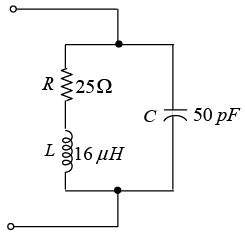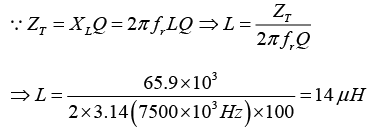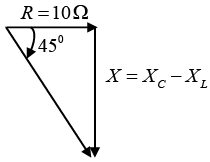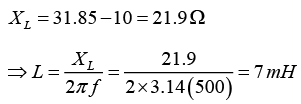AC Analysis of R, L, C Circuit: Assignment | Electricity & Magnetism - Physics PDF Download
Q.1. A voltage of 100V ac at a frequency of 10 kHz is impressed across a series circuit that consists of a 220 pF capacitor and an 800 mH coil with and internal resistance of 125Ω. As a series resonant circuit find
(a) the resonant frequency of the circuit,
(b) the current in the circuit,
(c) the voltage drops across the capacitor and the coil,
(d) the power dissipated by the resonant circuit,
(e) the Q of the coil,
(f) the total bandwidth and edge frequencies,
(g) the power dissipated by the circuit operating at the edge frequency.
As a series resonant circuit
(a)
(b) The current in the circuit is
(c) The voltage drops across the capacitor and the coil
XL= 2πfL = 6.28fL= 6.28(12x 103Hz)(800 x 10-3 H) ≈ 60288Ω = Xc
⇒ VL = VC = IXL = IXC = 48230V
(d) The power dissipated by the resonant circuit is P = VI = 100V x 0.8 A = 80W
(e) The Q of the coil is
(f) The total bandwidth and edge frequencies are
(g) The power dissipated by the circuit operating at the edge frequency is 40W
Q.2. A series circuit has a resistance of 30Ω, an inductance of 0.382H , and a capacitance of 0.2μF. Find
(a) the impedance of the circuit to a frequency of 500Hz,
(b) the Q of the circuit,
(c) the capacitance that must be added in parallel with the 0.2μF capacitor to produce resonance at this frequency
(d) the impedance of the circuit at resonance,
(e) the Q of the resonant circuit, and
(f) the bandwidth.
As a series resonant circuit
(a) XL = 2πfL = 6.28fL = 6.28 (500 Hz) (0.382 H) ≈ 1199 Ω
The impedance of the circuit to a frequency
(b) The Q of the circuit,
(c)
(d) The impedance of the circuit at resonance, Z = 30Ω
(e) The Q of the resonant circuit,
(f) The total bandwidth
Q.3. A 0.001μ F capacitor and a coil are connected in parallel to from the primary of an IF transformer. Find the inductance of the coil so that the circuit is resonant to a frequency of 460 kHz.
As a parallel resonant circuit
Q.4. An inductor with a measured Q of 100 resonates with a capacitor at 7500 kHz with an impedance of 65.9 kΩ. Find the value of the inductance and the capacitance of the test capacitor.
The impedance of the circuit at resonance
Q.5. A series RLC circuit R = 10Ω and C = 10μF has a leading phase angle of 450 at a frequency of 500 Hz . Find the frequency at which this circuit will be resonant.
Draw the impedance triangle and solve for the net reactance X
X = XC - XL = 10 tan 45° = 10Ω
Thus
As a series resonant circuit
Q.6. A voltage of 100V ac at a frequency of 10 kHz is impressed across a series circuit that consists of a 220 pF capacitor and an 800 mH coil with and internal resistance of 125 Ω. Find
(a) the current in the circuit
(b) the voltage drops across the capacitor and the coil,
(c) the power dissipated by the circuit and
(d) the Q of the coil.
(a) The current in the circuit
(b) The voltage drops across the capacitor and the coil
VL = IXL = 4.54 x 50 = 227V and Vc = IXc = 4.54 x 72 = 327 V
(c) The power dissipated by the circuit P = VI cosϕ
(d) The Q of the coil is
Q.7. A tuning capacitor is continuously variable between 20 and 350 pF . Find
(a) the inductance that must be connected in series with it to produce a lowest resonant frequency of 550 kHz, and then
(b) the highest resonant frequency.
(a) As a series resonant circuit
(b) The highest resonant frequency
Q.8. An inductor is connected in parallel with a 200 pF capacitor so that the circuit is resonant to 113kHz . A circuit magnification meter indicates that the Q of the inductor is 800. Find
(a) the effective resistance of the inductor
(b) the value of the inductance, and
(c) the impedance of the circuit at resonance.
(a)
(b) The Q of the coil is
(c) The impedance of the circuit at resonance
Q.9. A voltage of 100V ac at a frequency of 10 kHz is impressed across a series circuit that consists of a 220 pF capacitor and an 800 mH coil with and internal resistance of 125Ω. What type and value of ‘pure reactance’ must be added to the circuit to make it resonant at 10 kHz ?
As a series resonant circuit
⇒ L' = L1 + L2 ≈ 1154 mH ⇒ 800 mH + L2 ≈ 1154 mH⇒ L2 = 354 mH (in series)
Q.10. A 16μH coil and a 50 pF capacitor are connected in parallel as shown in figure below. If the effective resistance of the coil is 25Ω, find the resonant frequency, the Q of the coil at resonance, the bandwidth, and the edge frequencies.
As a parallel resonant circuit
The Q of the coil is
The total bandwidth and edge frequencies are
Q.11. A 0.1 H inductance, a 1μF capacitor, and a 5Ω resistor are connected in series across a supply voltage of 50V at a frequency of 503 Hz.
(a) Is the circuit resonant?
(b) Find the impedance of the circuit, and
(c) Find the amount of voltage across each component.
As a series resonant circuit
(a)
(b) XL = 2πfl = 6.28fL = 6.28(503)(0.1)≈316Ω = Xc
The current in the circuit is
The voltage drops across the capacitor and the coil
⇒ VL = VC = IXL = IXC = 3160V and VR = IR= 50V
Q.12. An inductor of 0.1mH with a Q of 90 is connected in parallel with a 253 pF capacitor.
Find
(a) the resonant frequency and bandwidth,
(b) the impedance of the circuit at resonance, and
(c) the effective resistance of the inductor.
(a) As a parallel resonant circuit
The total bandwidth and edge frequencies are
(b) The impedance of the circuit at resonance,
∵ ZT = XLQ = 2πfrLQ = 2 x 3.14 x (1000 x 103)(1 x 10-4H)x90 = 56.5kΩ
(c) The effective resistance of the inductor
The impedance of the circuit at resonance
|
82 videos|32 docs|22 tests
|
FAQs on AC Analysis of R, L, C Circuit: Assignment - Electricity & Magnetism - Physics
| 1. What is AC analysis of R, L, C circuit? |  |
| 2. How is AC analysis different from DC analysis in an R, L, C circuit? |  |
| 3. What are the key components of an R, L, C circuit in AC analysis? |  |
| 4. How is impedance calculated in an R, L, C circuit during AC analysis? |  |
| 5. What are the applications of AC analysis of R, L, C circuits? |  |



































































